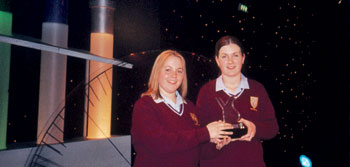| 2003 |

|
YEAR BOOK |
Jesus & Mary Secondary School, Enniscrone, Co. Sligo
|
A study of Radon and its isotopes in drinking water
|

Radon is a colourless, odourless and tasteless radioactive gas which originates in rocks and soils containing uranium. It is known to be a cancer causing agent. The air-born pathways have been studied in Ireland, but not water-borne pathways. Our project was the first research carried out in the Mayo/Sligo area using modern, reliable technology to investigate its impact.
The experimental work involved the collection of water samples from wells, water supplies, the sea, lakes, rivers and even our local swimming pool. Dr Peter Mitchell, of University College Dublin, offered us access to equipment and expertise in the Radiation Laboratory at UCD. We used a Liquid Scintillation Counter to determine the concentration of Radon-222 in the water samples.
The radon isotope we were tracking has a very short half-life of 3.82 days and it was necessary to stabilise it by using an organic solution that fluoresces when placed in the Liquid Scintillation Counter. We sourced this HEMOS (High Efficiency Mineral Oil Scintillator) in Great Britain.
We chose suitable sampling sites and planned the collection, delivery and testing of the samples within the half-life of radon. We trudged the roads and fields of Tireragh to collect our samples. The soluble radon was stabilised with the HEMOS solution in vials prepared previously in the school laboratory. We delivered our samples to UCD where we used the equipment to initiate testing. The team at UCD continued the testing.
The results showed that the Radon-222 isotope was present in 33% of our water sources. Samples below a background radon level of below 0.9 Becquerels per litre were disregarded, as this was the lowest activity concentration that can be reliably detected. The concentrations ranged from 6.1 Bq/1 to 49.08 Bq/1.
The main conclusion drawn from these results was that none of the tested water sources would require remedial action, as they were below the minimum safe level of 200 Bq/m 3 .
Our report recommended that ground waters in each county should be tested immediately, especially in areas known to be high in radon. We are aware of a programme currently being undertaken by the Radiological Institution of Ireland to address this issue.
Details of our project are available at: http://homepage.eircom.net/-radontesting .
Lisa Naughton & Rebecca Quinn entered their project in the Intermediate Group Section in the Chemistry, Physical & Mathematical Sciences Category at the Esat BT Young Scientist & Technology Exhibition in January 2003. They won one of the top prizes - Runner-Up Group Award.
Their teacher was Ms Margaret Kenny.
|
|